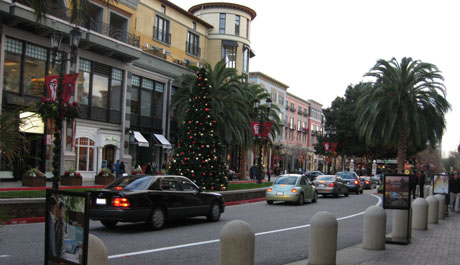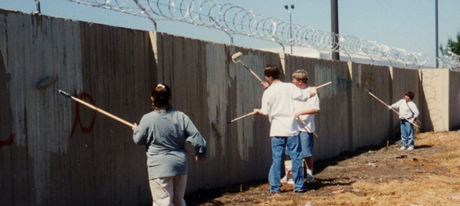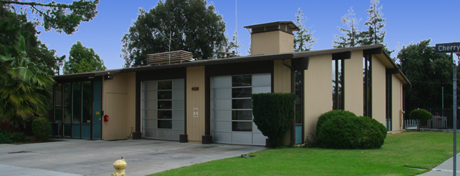Note: This is Pierluigi Oliverio’s 300th Post:

Negotiations between the city of San Jose and the Police Officers Association continue to be contentious. (Photo by Thomas Hawk).
Our goals for law enforcement in San Jose must be based on need and the amount of tax revenues on hand. As Gov. Jerry Brown stated last month, “People want to have more childcare, they want to have more people locked up, they want to have more rehab, more, more, more. More judges, more courtrooms. We have to live within reasonable limits.”
San Jose has no choice but to operate in the world of reasonable limits, and it can only allocate money that is actually on hand. The city should not make new promises that cannot be kept.
Much has been said recently about law enforcement budgeting. A year ago, I wrote two articles suggesting a specific percentage of the budget should be allocated to police, thus allowing the police department to grow in keeping with future tax revenues and a growing population. Those previous posts can be found here and here.
Since this is not the case today, I must work within the current system.
One of the shared community goals is to increase the actual number of police officers. In addition, another shared community goal is for pension reform. In my opinion, these two objectives are inextricably linked. Back in 2010, I initiated, and a majority of the City Council supported, ballot Measure W. Voters in November 2010 approved Measure W by more than 72 percent. This gave us—for the first time ever in San Jose—the ability to create a new, lower cost pension plan for future employees.
Since the passage of Measure W, a second-tier pension system has been implemented for all new city employees, except for fire and police. Neither the fire nor the police unions agreed to accept a new retirement plan for future employees—again, we are talking about people who do not even work here yet. The restructured, lower-cost retirement plan for new hires is fundamental to financial stability, and it allows us to add new police officers over time as savings are achieved through pension reform.
Countless other government entities across our state and country have implemented a tiered pension system that includes public safety unions. In my view, a second tier must be in place for fire and police prior to any compensation discussions. Again, our Governor clearly agrees with this line of reasoning: “Pension reform can be hard to talk about,” he said. “In the long run, reform now means fewer demands for layoffs and less draconian measures in the future.”
When it comes to the present discussion on compensation, one option is to give all employees an ongoing raise. While an ongoing compensation increase may be ideal, there is no money to backfill it next fiscal year, which would then result in 100 percent pay cuts for some city employees—in other words, layoffs. Every 1-percent compensation increase to all city employees would cost $7.9 million per year. However, this assumes that all positions are equal in value, and are equal in terms of interest for recruitment purposes. I can guarantee that in any outcome achieved, no one will be happy since tax dollars are finite. Those who want, may not get; and those who get, may want more. Knowing this, I suggest an option for cash in hand now for those who enforce the Social Contract.
This proposal would function in the following manner: Each police officer would be given the option to select a scheduled redemption of their accrued benefit of up to $15,000 over 15 months, starting in the upcoming fiscal year. The $15,000 could be derived—by employee choice—from any of three accrued sources: comp time, sick leave or vacation time. These three accrued sources currently add up to over $50 million just for police officers alone, the majority of which is sick leave at approximately $36 million. This $50 million is recorded as an accounting liability and must be paid out when someone retires or resigns.
Paying a portion of this out now would reduce future payouts that would be even more costly in the future, as accrued benefits are typically earned at a lower pay scale but always paid out at the highest pay scale. This action would also enable a future council to have more money to fund city services. The $15,000 payout option would cost approximately $15.2 million if every police officer was to redeem the maximum, and would consume over half of the $22.5 million in one-time funds that are available.
There is also potential to add new police officers. On Tuesday, the council will take action on a $6.9 million reimbursement from the county on property tax recalculation. This one time windfall of money should go directly to hiring new police officers if, and only if, a new retirement plan is in place for the police union. This money could be used to “hire ahead,” which would front the cost of new officers being vetted to coincide with future vacancies as current officers retire or leave. Incidentally, $6.9 million is approximately the same amount of money the city pays to subsidize golf and the Hayes Mansion each year.
The fact is that each individual has their own economic situation, which may or may not include a variety of personal factors. Whatever the situation may be, it is impossible to examine each police officer’s household income and ensure that they are paid according to their needs. This option ultimately allows the individual to choose what is best. One individual may choose to redeem the maximum amount, while another may redeem half, while yet another may choose to not redeem at all, instead saving it up for a future potential payout. This option is based on individualism rather than collectivism.
With this spirit in mind, we acknowledge that individuals will pursue their own happiness, and, as a result, may seek employment elsewhere or a different vocation.





